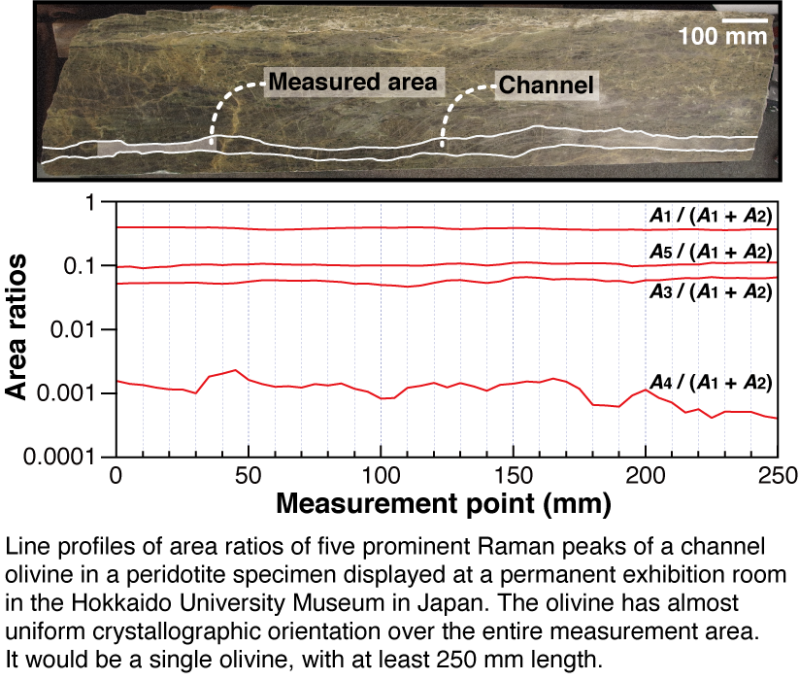
Raman spectroscopic identification of continuity of a channel olivine in a peridotite specimen
ABSTRACT

In the Horoman peridotite complex, the peridotite containing olivine-filled channels is known to exist. To examine the distribution pattern of the channel olivine, we performed non-destructive microanalyses of Raman spectra at 51 points of the olivine with 5 mm intervals along the channel. Compared with the Raman spectra of a reference euhedral olivine, for which the crystallographic orientation is known, there is no abrupt change in the crystallographic orientation in the 250 mm line analysis region of the channel. Moreover, Mg/Fe ratios of the channel olivine show gradual change over the entire measured area. If the channel olivine is an aggregate of olivine grains crystallized from magma infiltrating into the channel, then there should be olivine grains with both uneven crystallographic orientation and a homogeneous Mg/Fe ratio. Therefore, the olivine in the channel is regarded as a single crystal with slight growth zoning. The peridotite with the channel had been a part of mantle that was uplifted by the collision of plates. Therefore, the channel is a trace of magma migrating in the mantle. Magma migration in mantle drives the material–thermal circulation system connecting the Earth’s interior and surface. Furthermore, the size of the mineral in mantle reflects its stress field. Therefore, the magma channel involving such a large olivine is a unique specimen that reveals the particular characteristics of magmatism occurring in the Earth’s interior.
KEYWORDS
crystallographic orientation, dunite channel, mantle, olivine, Raman spectroscopySupplementary Materials(file)
https://www.jstage.jst.go.jp/article/geochemj/56/1/56_GJ22003/_supplement/_download/56_GJ22003_1.pdf
- Published : 2022
- Released on J-STAGE : 2022/02/28
- Received : 2021/05/24
- Accepted : 2021/09/29
- DOI : https://doi.org/10.2343/geochemj.GJ22003
- J-STAGE URL : https://www.jstage.jst.go.jp/article/geochemj/56/1/56_GJ22003/_article/-char/ja
- J-Online ISSN: 1880-5973
- Print ISSN : 0016-7002
- ISSN-L : 0016-7002
All Issues
- Vol.59, 2025
- Vol.58, 2024
- Vol.57, 2023
- Vol.56, 2022
- Vol.55, 2021
- Vol.54, 2020
- Vol.53, 2019
- Vol.52, 2018
- Vol.51, 2017
- Vol.50, 2016
- Vol.49, 2015
- Vol.48, 2014
- Vol.47, 2013
- Vol.46, 2012
- Vol.45, 2011
- Vol.44, 2010
- Vol.43, 2009
- Vol.42, 2008
- Vol.41, 2007
- Vol.40, 2006
- Vol.39, 2005
- Vol.38, 2004
- Vol.37, 2003
- Vol.36, 2002
- Vol.35, 2001
- Vol.34, 2000
- Vol.33, 1999
- Vol.32, 1998
- Vol.31, 1997
- Vol.30, 1996
- Vol.29, 1995
- Vol.28, 1994
- Vol.27, 1993
- Vol.26, 1992
- Vol.25, 1991
- Vol.24, 1990
- Vol.23, 1989
- Vol.22, 1988
- Vol.21, 1987
- Vol.20, 1986
- Vol.19, 1985-1986
- Vol.18, 1984
- Vol.17, 1983
- Vol.16, 1982
- Vol.15, 1981
- Vol.14, 1980
- Vol.13, 1979
- Vol.12, 1978
- Vol.11, 1977
- Vol.10, 1976
- Vol.9, 1975
- Vol.8, 1974
- Vol.7, 1973
- Vol.6, 1972-1973
- Vol.5, 1971
- Vol.4, 1970-1971
- Vol.3, 1969-1970
- Vol.2, 1968
- Vol.1, 1966-1967




